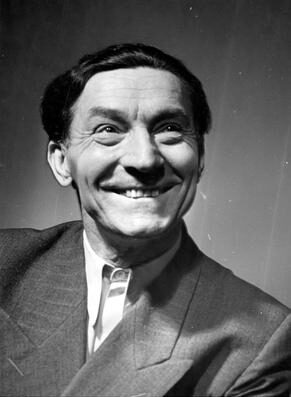Feliks Parnell (b. Feliks Jan Grzybek) was born on December 13, 1898 in Żyrardów. He was a dancer and choreographer, and went down as a key figure in the history of Polish dance.
Starting in 1910, Parnell studied dance at the Warsaw Ballet School. In the course of his career, he collaborated with numerous operetta theaters, cabarets and revues: Bagatela, Mirage, Qui Pro Quo, Novelties, Stańczyk, Morskie Oko, Polski Theater, Cyganeria, Hollywood and Stara Banda. He also worked as a dancer, choreographer, team leader and ballet master in various opera, ballet and dramatic theater companies, including the Słowacki Theater in Cracow, the Moniuszko Opera in Poznań, the Wrocław Opera, the Warsaw Opera, the Łódź Opera, the Jaracz Theater in Łódź, the Cracow Opera, and the Lower Silesian Operetta.
In 1925, Parnell founded his own dance company, with whom performed in France, Italy, Algiers, Tunis, Spain and Switzerland until the end of the season. At the end of 1934, he set up an auteur Ballet Parnell, which debuted on February 1, 1935 on the stage of Wielka Rewia. By 1939, the company, known as the Ballet Polonais de Parnell, enjoyed international success. During the German occupation of Poland, Parnell danced and led the ballet in Warsaw’s open theater companies: Nowości and Miniatura.
After his retirement, he continued to work as a choreographer with numerous companies in Poland, also appearing in the film production Meeting on the Atlantic (directed by J. Kieślowski 1980).
Feliks Parnell died on April 4, 1980 in Łódź.
As a dancer, Parnell established himself as energetic and expressive. An exceptionally gifted actor, he did not shy from integrating acrobatic elements in dance. His choreographies, in which he mostly participated, also required dancers to be physically fit, able to convey symbolic content, and often straddle the grotesque and the humorous.
The most important feature of Feliks Parnell’s oeuvre was his turn to Polish culture and tradition. The artist used folk themes and the music of Polish composers in his own unique way, reinterpreting Polish dance folklore and setting new directions in this field.
Serge Lifar, one of the greatest choreographers in the history of world ballet, said of Parnell: “When Parnell and his partners throw themselves into the vortex of a mazurka it seems that the walls, the floor, and you yourselves join in on the dance, swept away by its rhythm. The soul of a country lies not only in its books and museums, but also in the rhythm of the dancer.”
Felix Parnell’s original works were appreciated both in Poland and abroad. He mostly performed the leading roles in his ballets himself, starring in, among others: The History of Dance (dir. Felix Parnell, 1947), Halka (music by S. Moniuszko, dir. Jan Popiel, 1949), Master Twardowski (music by L. Różycki, chor., dir., stage design Felix Parnell, 1955), Parnell’s Parades (dir. Felix Parnell, 1957/58), Giselle (music by A. Adam, chor. and dir. Felix Parnell, 1959), Świtezianka, or the Water Queen (music by E. Morawski, dir. Felix Parnell, 1960), The Fountain of Bakhchysarai (music by B. Asafiev, adapted, staged and directed by Felix Parnell, 1961), Coppelia (music by L.Delibes, staged and directed by Felix Parnell, 1962), Carmina Burana (music by C. Orff, staged by Leo Nedomansky, 1963), Czaromysł, or the Nymphs of Lake Gopło (music by K. Kurpiński, staged by Andrzej Szalawski, 1968).
Parnell also created numerous thematic nights with mixed programs featuring his dance miniatures. Some of his most famous miniatures include: Obertas Zawierucha, The Archer, The Indian, The Spider and the Fly, Umarł Maciek umarł, The Wedding of Łowicz, The Harvest Festival, The Cracow Lajkonik, Terpsichore in the Backyard.
In 1936, Parnell and his company Ballet Polonaise de Parnell won First Prize at the Berlin Dance Olympiad.
In 1939, he received the Golden Cross of Merit for his achievements in the field of dance.
In 1964, he received the Prize of the Ministry of Culture and Art.
In 1979, he was awarded the Prize of the City of Łódź for his lifetime achievements in the field of ballet.
Since 1988, Felix Parnell has been the patron of the Lódź Ballet School.
Bibliography:
Tacjanna Wysocka Dzieje baletu, Państwowy Instytut Wydawniczy, Warszawa 1970.
Feliks Parnell , Encyklopedia Teatru Polskiego Feliks Parnell ::: Osoby ::: Encyklopedia teatru polskiego (accessed December 8, 2023).
Internetowy System Aktów Prawnych, Zarządzenie M.P. 1939 nr 185 poz. 458, Zarządzenie o nadaniu Złotego Krzyża Zasługi (sejm.gov.pl) (accessed December 8, 2023).
Official website of the Feliks Parnell Ballet School in Łódź, Ogólnokształcąca Szkoła Baletowa im. Feliksa Parnella w Łodzi (archive.org), (accessed December 8, 2023).
